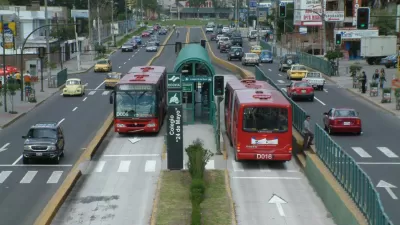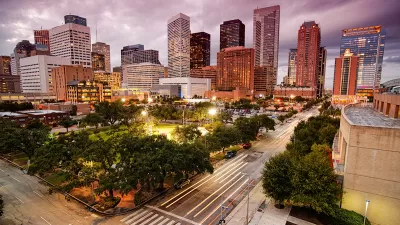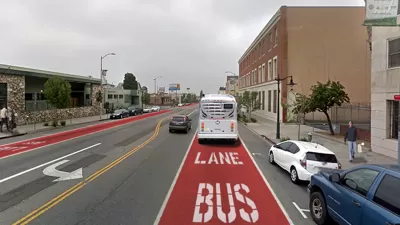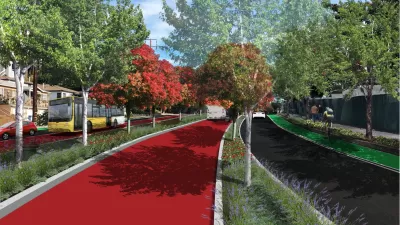As cities look to rebuild their transit systems, bus rapid transit provides a cheap and effective way to expand access and boost speed.

More cities are starting to look to bus rapid transit, known as BRT, to improve their transit options and make routes more efficient, reports Ian Duncan. "The lines take the humblest form of public transit, the city bus, and supercharge it using a combination of technology, road redesigns and route planning tweaks." BRT projects "are particularly appealing in smaller urban areas and the less dense communities that dominate the American landscape where subways and light rails are hard to justify."
Some experts, however, caution that "many lines that are dubbed BRTs involve only limited upgrades to bus service. They say those kinds of lines are not likely to tame urban sprawl or lure suburban drivers out of their cars." While "[t]he most elaborate systems involve dedicated busways with stops that mimic a light-rail station and facilities to buy tickets on the street, as well as speeds that can rival rail. But many such bus lines in the United States are more basic, largely involving stops that are further apart and technology that changes stop lights to green as buses approach."
Meanwhile, "[s]ome warn that betting on a form of transit well suited to America’s road-dominated cities and suburbs could be counterproductive: an unhappy middle way that offers modestly better service and does not promote the kind of denser communities that allow transit to thrive." But "[t]here are indications that BRT lines can promote some of the density long associated with rail routes," and, in the meantime, can more effectively connect people to jobs and amenities for a fraction of the cost of rail.
FULL STORY: Cities are turning to supercharged bus routes to more quickly and cheaply expand transit services

Planetizen Federal Action Tracker
A weekly monitor of how Trump’s orders and actions are impacting planners and planning in America.

Congressman Proposes Bill to Rename DC Metro “Trump Train”
The Make Autorail Great Again Act would withhold federal funding to the system until the Washington Metropolitan Area Transit Authority (WMATA), rebrands as the Washington Metropolitan Authority for Greater Access (WMAGA).

The Simple Legislative Tool Transforming Vacant Downtowns
In California, Michigan and Georgia, an easy win is bringing dollars — and delight — back to city centers.

Supporting Cycling Takes More Than Just Bike Lanes
Safe, protected bike lanes are a key part of a city’s bike infrastructure — but secure parking, e-bike charging, and other amenities can also influence people’s shift to cycling.

Judge Blocks Anti-DEI Rules for Transportation, Housing Grants
A second injunction blocks the Trump administration from enforcing new regulations for federal funding.

Unhoused People in San Jose Could Face Arrest if They Refuse Shelter
A policy proposed by the city’s mayor would give law enforcement the option to arrest homeless residents if they refuse three offers of housing.
Urban Design for Planners 1: Software Tools
This six-course series explores essential urban design concepts using open source software and equips planners with the tools they need to participate fully in the urban design process.
Planning for Universal Design
Learn the tools for implementing Universal Design in planning regulations.
Smith Gee Studio
City of Charlotte
City of Camden Redevelopment Agency
City of Astoria
Transportation Research & Education Center (TREC) at Portland State University
US High Speed Rail Association
City of Camden Redevelopment Agency
Municipality of Princeton (NJ)





























